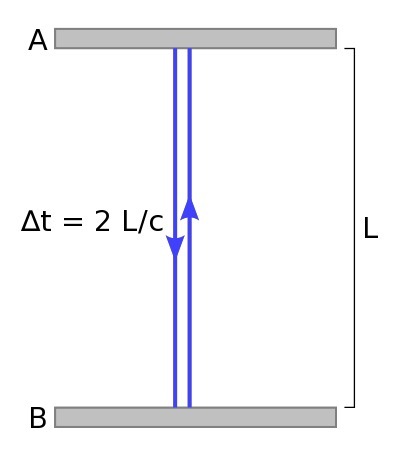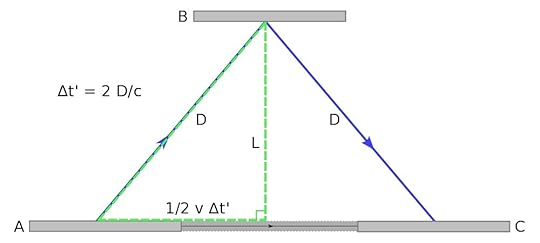The Sword and Laser discussion

This topic is about
Altered Carbon
2014 Reads
>
AC: How does time really work?
date newest »
newest »
 newest »
newest »
 A lot of SF uses workarounds to get around the lightspeed limitations. Usually it's wormholes or something similar to get physically from one place to another. Information tends to be sent via "subspace" or "hyperspace." In Altered Carbon, Kovacs' data was sent via near-instantaneous hyperspatial needlecast (p. 37 if my Kindle is right).
A lot of SF uses workarounds to get around the lightspeed limitations. Usually it's wormholes or something similar to get physically from one place to another. Information tends to be sent via "subspace" or "hyperspace." In Altered Carbon, Kovacs' data was sent via near-instantaneous hyperspatial needlecast (p. 37 if my Kindle is right).
 I read something about time a few months ago that made complete sense & made me feel stupid for not thinking of it before: WE EXPERIENCE TIME ONLY BECAUSE THINGS CHANGE.
I read something about time a few months ago that made complete sense & made me feel stupid for not thinking of it before: WE EXPERIENCE TIME ONLY BECAUSE THINGS CHANGE.The seasons, phases of the moon, people/plants/animals coming into being, maturing and then dying. If we didn't have change, we wouldn't have time.
Maybe everyone else had figured this out, but it kinda blew my mind.
 Except that's not time, without those things, time would still progress, we would simply have no perception of it.
Except that's not time, without those things, time would still progress, we would simply have no perception of it.
 I read somewhere that time is connected to gravity. That the closer to gravity you are the slower time passes for you. They showed this by putting one clock on the bottom of a skyscraper and one clock on the top. Sure enough the two had different times. I think it was a difference of like a second or minute something like that but over time that would add up to a person. And I feel time all the time even without change. It passes us by all the time. And people in places like Arizona don't really get any change and still have a good concept of time.
I read somewhere that time is connected to gravity. That the closer to gravity you are the slower time passes for you. They showed this by putting one clock on the bottom of a skyscraper and one clock on the top. Sure enough the two had different times. I think it was a difference of like a second or minute something like that but over time that would add up to a person. And I feel time all the time even without change. It passes us by all the time. And people in places like Arizona don't really get any change and still have a good concept of time.
 Think of time as a river. It flows at different rates around different things. If there's a large boulder, the water flows slower around the boulder but faster farther away from it.
Think of time as a river. It flows at different rates around different things. If there's a large boulder, the water flows slower around the boulder but faster farther away from it....Stephen Hawking explained it better.
Christopher wrote: "I think it was a difference of like a second or minute something like that but over time that would add up to a person."
Over a lifetime it would be insignificant. A very small fraction of a second.
Over a lifetime it would be insignificant. A very small fraction of a second.
 Tassie Dave wrote: "Christopher wrote: "I think it was a difference of like a second or minute something like that but over time that would add up to a person."
Tassie Dave wrote: "Christopher wrote: "I think it was a difference of like a second or minute something like that but over time that would add up to a person."Over a lifetime it would be insignificant. A very small..."
Yes - but both the top of the skyscraper and the bottom would still occupy the same time reference - the top of the skyscraper doesn't exist in the future and the bottom doesn't exist in the past even though the clocks don't sync perfectly.
 Jay wrote: "I find the "objective vs. subjective" time idea very interesting. I haven't studied time much also currently reading Speaker for the Dead by Orson Scott card. In that book time is relative to your ..."
Jay wrote: "I find the "objective vs. subjective" time idea very interesting. I haven't studied time much also currently reading Speaker for the Dead by Orson Scott card. In that book time is relative to your ..."Fair warning, this got a little long...
When they refer to objective time, they mean the actual time passed in relation to the rest of the universe, where subjective would be the amount of time that the person has actually experienced.
So, let's say that Kovacs was initially stored at birth 300 years ago. Objectively, he is 300 years old (300 years have passed since he first began existing). However, he probably did not have had a sleeve to live in for that entire time. So maybe he lived in his initial body for 20 years, then had 5 years in some new body, and another 15 in one after that, all throughout those 300 objective years. From his (subjective) perspective, he has been alive for 40 years.
As far as time being relative to the solar system in which you live... remember that our estimation of a year is the completely arbitrary amount of time that it takes our planet to orbit around the sun once. Obviously other planets will have a different period for each solar revolution, so I've been assuming that, whenever they talk about years, they're referring to a universal standard (which would probably be Earth years).
If you're really interested in relativity... well... I do like to dust off this post every few books...
Here are the basics for relativistic travel (travel near the speed of light).
Imagine a clock that is composed of 2 mirrors (A and B) facing each other with a separation of length L. A single photon of light is bouncing between them, and each time the photon hits A, the clock ticks once.

Then we know that the time between ticks is
Now imagine that you're moving parallel to this clock at speed v, such that you are seeing the light trace a different path, as so:

Now, and this is important, from your perspective (i.e. frame of reference), the light is traveling a distance 2D rather than 2L, making the period of the clock
See the right triangle? The Pythagorean Theorem (
Do a little math (substitute D into the 2nd equation and solve for delta t'), and you reach the following:

But look! That part on top is just our earlier equation for the observed time when you're at rest, therefore:
 .
.What does this mean? As v approaches c, the denominator of the equation approaches zero, which means that the observed time of a person moving in a very very fast frame of reference will grow very very large the closer they come to the speed of light. This means that they will literally experience less time than someone moving more slowly will over the same period of time.
An example!
Say that you're moving at V = (one half the speed of light) = (c/2) and T = (the change in time you would have experienced at rest). Then we have...
t' = T/(1-1/4)^(1/2) = 2T/3^(1/2), or (3^(1/2))t' = 2T.
So for every 2 units of time (seconds, days, years...) that take place at rest (no movement, or in more practical terms movement not approaching a significant fraction of the speed of light), only 3^(1/2) take place while moving at half the speed of light. Therefore, the faster you move the slower time gets for you, relative to someone moving slower.
Check a GPS if you don't believe me; they use these equations every single day to correct for the differences in speed between them and the surface of the Earth.
I doubt anyone's actually read this far, but as Rick said, go to http://en.wikipedia.org/wiki/Time_dil... for a more thorough explanation.
 I read that far. Been several decades since I studied this, and I don't remember it being explained in that way. I like an explanation I might be able to remember well enough to recreate! (But don't quiz me on it.)
I read that far. Been several decades since I studied this, and I don't remember it being explained in that way. I like an explanation I might be able to remember well enough to recreate! (But don't quiz me on it.)
 I recently saw a BBC special that had an interesting demonstration of this principal.
I recently saw a BBC special that had an interesting demonstration of this principal.Sit someone on an office chair and get then to hold a flash light and move it up and down to represent the photons bouncing between the mirrors. Now push the office chair across the room.
From the guy on the chairs perspective, the photons are still bouncing directly up and down. For someone observing from a distance the photons describe a sine wave because they are moving up and down AND moving along with the chair.
It's obvious that the path of the sine wave is longer than the straight up and down distance so if the speed of the light is always constant then the only explanation is that time must be different to allow the travel of a longer distance. You can do the math from there:)
 There's a book I read part of that talks about relativity, time, and such in an interesting way through demos done by characters, Time: A Traveler's Guide. That author does similar books about other science and math topics, I really enjoy them :).
There's a book I read part of that talks about relativity, time, and such in an interesting way through demos done by characters, Time: A Traveler's Guide. That author does similar books about other science and math topics, I really enjoy them :).




http://en.wikipedia.org/wiki/Time_dil... if you're interested.